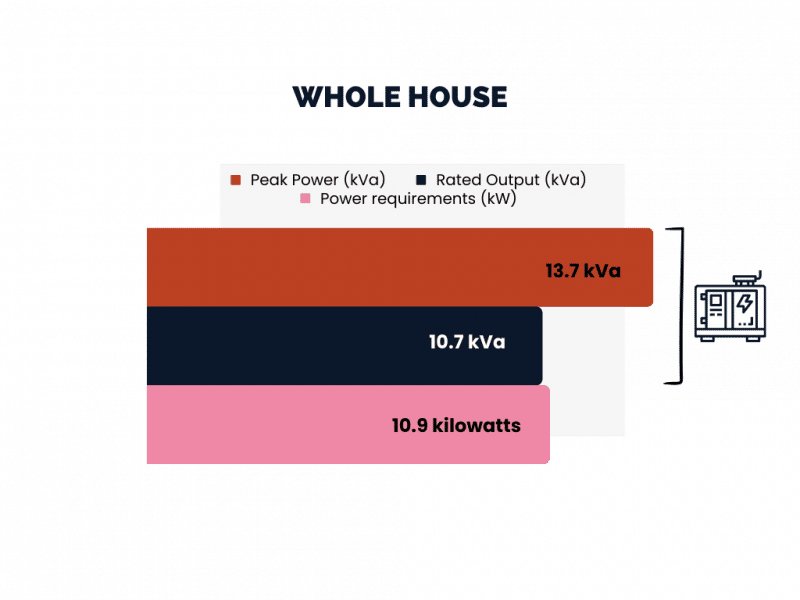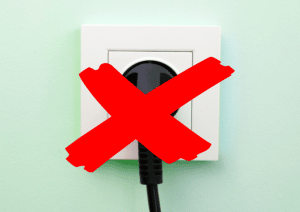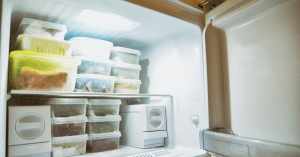We recently had a 4-day power outage in Tasmania. A severe weather event blew through and took the power lines with it. Knowing what I do for a living, one of the neighbours approached me. “What size generator do I need for a 3 bedroom house?”, he wanted to know. The devil, I told him, is in the detail. It is tricky to select the right generator size. Getting it wrong costs thousands. There are energy calculations and conversions to do. Like a good neighbour, I helped him out. The result will save you hours if you’re looking for a home generator. So here are the calculations, along with a free appliance cheatsheet and the answers you’re looking for…
Nice and easy, right?
What size generator do I need for a 3 bedroom house?
Budget option
At a minimum, you need a backup generator with 6.7 kVa of peak power and 3.7 kVa of rated output for a 3 bedroom house. This is a ‘budget option‘.
We’re talking here about traditional fuel generators – diesel, gas, petrol.
This size generator will power only critical household equipment in you 3 bedroom house. It’s a suitable size for minor power outages of 24 hours.
You can get away with a portable generator at this size.
You can also get a portable power station / solar generator that will meet your budget option needs. These can cost more than traditional fuel generators up front, but have no running or maintenance costs.

Typical household
To provide backup power supply for a typical family in a 3 bedroom house, you will need a large generator with 9.4 kVa of peak power and 6.4 kVa rated output. A generator this size will run critical appliances + some discretionary ones in a power outage.
This larger generator suits extended power outages of more than 3 days. It will power more appliances, meaning fewer disruptions to your comfort and lifestyle. There are a still sacrifices to make when it comes to the appliances you can run.
There are also portable solar generators that run on electrical energy (batteries and solar power) that can meet the backup power needs of a typical household. These don’t make noise or emit noxious gases, and can be run from inside your home.
Whole house
To power a whole 3 bedroom house, a backup generator with a peak output of 13.7 kVa and rated output of 10.7 kVa will do the job.
This size generator suits extended blackouts. It won’t power every appliance you own. But it will allow you to live a comfortable lifestyle when the grid is down.
At this size, you’re looking at standby or conventional heavy duty generators, installed via a transfer switch.
A portable power station with expandable power capacity or a solar and gas generator can also meet these heavy duty power needs.
In this post, we’re going to run through each of these examples – budget option, typical household, whole house – so you know the benefits and trade-off of each one.
We’ll list out all the appliances you can power, and the generator size you’ll need.
No calculations or conversions necessary!
Key concepts before we begin
There are 3 concepts that will help you to understand each example. These concepts will also help you shop for a backup generator. They are:
- The key electricity concepts for generator sizing
- How you run your appliances can save you money (on generator buying and running costs)
- How and why to avoid overloading the generator (hint – it will also save you $$).
1. Important electricity terms and what they mean
To benefit from our real life examples, you’ll need to first understand these 5 electricity terms:
1. Power requirements
The appliances you want to run determine your home power requirements. Your power requirements are just your energy needs. How much power you use at home.
Power requirements are measured in ‘watts‘. The appliances and devices you plug in at home determine how many watts your home uses.
You can find how many ‘watts’ your appliances use on the nameplate for each appliance. But don’t worry, we provide watt estimates in each real world example below.
Your power requirements are important because they determine what size generator you need.
It’s a simple formula.
Power requirements = highest starting watt + total running watts.
2. Starting wattage
This is the amount of power that’s needed for initial startup of an appliance. Some appliances, like a fridge, take more power to start up than to run. We pick the appliance with highest starting watts and use that number to calculate generator size.
3. Running wattage
This is the amount of electricity that’s required to keep your appliances running for continuous long hours. To work out generator size, we add the total runnings watts of all your appliances to the highest starting watts number. That’s the formula above!
Now we’ve explained the formula ‘Power requirements = highest starting watts + total running watts‘, let’s move on to generator ratings. These tell us the generator size, or how much power it can produce.
4. Peak power
Peak power is the maximum threshold or amount of electricity a generator can produce in a short burst, such as to start up an appliance.
5. Rated output
A generator’s ‘Rated output’ is the amount of electricity it can produce continuously over time. It’s another measure of size.
Peak power and rated output are typically measured in KVa, in watts (W), or in kilowatts (kW). 1 kW is equal to 1,000 watts.
6. kVa (Kilovolt Amperes)
Kilovolt amperes is a unit of measure that tells us the size of the generator. 1 kVa is equal to 1,000 volt amperes. We covert watts into kVa so you know what size generator you’ll need. You can read more about why kVa is used, if you’re interested.
2. How to size a generator for a house
There are two rules of thumb to work out how big of a generator you need to power a house. Not following these rules can mean overloading your generator, or running it too hard and reducing its lifespan.
Here are the two rules of thumb:
- Your ‘total power requirements’ at any one instant must be lower than the generator’s ‘peak power’.
You manage this by staggering the timing of when you start up large appliances.
- Your total ‘running watts’ at any one time must be lower than the generators ‘rated output’.
You manage this not running all appliances at the same time.
If you follow these rules, you can power your house with a smaller generator in an emergency power outage. This will save you money and reduce runnings costs (e.g. diesel or petrol).
Our real life examples help demonstrate how this works in practice.
3. How to avoid overloading your backup generator
To buy a smaller backup generator (saves money) and avoid overloading it, it’s best to manage how you use your appliances with the generator. Our examples use 3 appliance categories to demonstrate:
- (*) Base Load Appliances. These appliances never turn off. You typically use them at the same time as each other and any other appliance.
- (**) Core Load Appliances. These appliances add to your base load (*) power use. You can use these appliance at the same time as your base load (*), and each other (without overloading the generator).
- The remaining appliances are Supplementary Load. You can use them at the same time as your base load. But you must be careful using them at the same time as Core Load (**) or you might overload the generator.
Remember, the aim is to buy the right size generator for your 3 bedroom house, without overpaying. It’s also to run the generator without overloading it.
Lets look at how this works in example one – the budget option.
Example 1 – backup generator for 3 bedroom house (budget)

This example is for a family of 4 in a 3 bedroom house. Let’s look at the amenities the backup generator will provide.
The aim on a budget is to run the most critical appliances. What is ‘critical’ will vary from family to family. We’re including essential appliances for basic human survival needs: water, warmth, food, communication. We’ll add to that sanitation and sanity. You’ll see what we mean in a minute.
In this example, we aim firstly to keep the lights on (LED lighting circuits).
We also want to prevent cold goods from going off, so the generator will run essential equipment such as the fridge and freezer.
Hot showers are important to comfort and hygiene in Australia so we’ve allowed for them. In this example we’ve assumed the household has energy efficient instantaneous gas hot water.
If you have electric hot water, you’ll need to add around 4,000 watts to the example below.
Our budget backup generator will provide limited space heating only. This may not be enough if you’re in southern states. Unless you have a wood heater in Victoria, Tasmania, NSW, you may need to add heat for power outages in the winter months.
We also have an NBN box, modem and an LED TV for entertainment. For portable appliances we include mobile device charging for 4 people and two laptop computers. These items are mostly to keep the internet running, keep you connected to emergency information, and keep children occupied. This is the sanity bit.
All cooking is done outside on a gas barbecue. If that’s not practical where you are, take a look at Example 2 below.
Here are the all of appliances you can power, and the generator size you’ll need.
| Appliance | No. of Units | Starting Watts | Running watts | Total Running watts |
|---|---|---|---|---|
| Fridge* | 1 | 2400 | 800 | 800 |
| LED Lights* | 30 | 0 | 9 | 270 |
| Freezer* | 1 | 1500 | 500 | 500 |
| NBN Box* | 1 | 0 | 50 | 50 |
| Internet Modem* | 1 | 0 | 20 | 20 |
| Instantaneous hot water** | 1 | 0 | 50 | 50 |
| Apple TV box** | 1 | 0 | 7 | 7 |
| LED TV** | 1 | 0 | 50 | 50 |
| Space oil heater (sml)** | 1 | 1500 | 1260 | 1260 |
| Mobile phone charger | 4 | 0 | 25 | 0 |
| Laptop | 2 | o | 85 | 0 |
| Total Running Watts | 2,957 watts | |||
| Highest Starting Watts | 2,400 watts | |||
| TOTAL POWER REQUIREMENTS | 5,357 watts | |||
| GENERATOR PEAK POWER | 6.7 kVa | |||
| GENERATOR RATED OUTPUT | 3.7 kVa |
Example 2 – Backup generator for typical family

For a typical household, we’ve kept everything from Example 1, and added a few amenities. Doing so increases the size of the generator, and your costs..
The addition of an induction cooktop in Example 2 means you can cook inside. Indoor cooking becomes more valuable in a black out of 3 days or more. But it also adds over 2000 watts to your Core Load.
You can also iron and use a hairdryer. These are important if a blackout lasts 3 days or more and you need to go to work.
This larger generator will only work if you can avoid running the iron and hairdryer at the same time as your Core Load (**). You’ll need to turn Core Load appliances off when you use either these two items.
In practice, that just means not using the iron or the hair dryer when the cooktop is on. A pretty easy thing to manage and it will save you on generator costs.
A typical family can run multiple home appliances with this generator size.
| Appliance | No. of Units | Starting Watts | Running watts | Total Running watts |
|---|---|---|---|---|
| Fridge* | 1 | 2400 | 800 | 800 |
| LED Lights* | 30 | 0 | 9 | 270 |
| Freezer* | 1 | 1500 | 500 | 500 |
| NBN Box* | 1 | 0 | 50 | 50 |
| Internet Modem* | 1 | 0 | 20 | 20 |
| Instantaneous hot water** | 1 | 0 | 50 | 50 |
| Apple TV box** | 1 | 0 | 7 | 7 |
| LED TV** | 1 | 0 | 50 | 50 |
| Space oil heater (sml)** | 1 | 1500 | 1260 | 1260 |
| Cooktop (induction)** | 1 | 0 | 2100 | 2100 |
| Mobile phone charger | 4 | 0 | 25 | 0 |
| Laptop | 2 | o | 85 | 0 |
| Iron | 1 | 0 | 1200 | 0 |
| Hairdryer | 1 | 0 | 1250 | 0 |
| Total Running Watts | 5,107 watts | |||
| Highest Starting Watts | 2,400 watts | |||
| TOTAL POWER REQUIREMENTS | 7,507 watts | |||
| GENERATOR PEAK POWER | 9.4 kVa | |||
| GENERATOR RATED OUTPUT | 6.4 kVa |
Example 3 – Backup generator to run the whole house

When we say ‘whole house’ you’ll see that we’re not powering every single appliance you own. There are some common major appliances missing. Like an oven, clothes dryer and coffee maker. There are no air conditioners or electrical tools either. The reason for this is cost.
This example still sacrifices on lifestyle to save you money. There are no ceiling fans or additional space heating. You’ll be sweeping the floors, hand washing the dishes and drinking instant coffee when the electric grid goes down.
These trade-offs can save you thousands in generator costs over the long term.
So what amenities have we added?
You’ll be able to wash your clothes, make toast, boil the kettle, and play on the Xbox (or your kids will) in this example.
As in Example 2, you can’t use your iron, hairdryer or toaster at the same time, or with your Core Load. Turn off the kettle or the cooktop to turn on one of these 3 items.
If you want to run everything on this list at the same time, you’re going to need a bigger generator!
| Appliance | No. of Units | Starting Watts | Running watts | Total Running watts |
|---|---|---|---|---|
| Fridge* | 1 | 2400 | 800 | 800 |
| LED Lights* | 30 | 0 | 9 | 270 |
| Freezer* | 1 | 1500 | 500 | 500 |
| NBN Box* | 1 | 0 | 50 | 50 |
| Internet Modem* | 1 | 0 | 20 | 20 |
| Instantaneous hot water** | 1 | 0 | 50 | 50 |
| Apple TV box** | 1 | 0 | 7 | 7 |
| LED TV** | 1 | 0 | 50 | 50 |
| Space oil heater (sml)** | 1 | 1500 | 1260 | 1260 |
| Cooktop (induction)** | 1 | 0 | 2100 | 2100 |
| Kettle** | 1 | 2400 | 2000 | 2000 |
| Washing machine** | 1 | 2250 | 1150 | 1150 |
| Game Console** (Xbox, PS4, Wii) | 1 | 0 | 140 | 140 |
| Mobile phone charger | 4 | 0 | 25 | 0 |
| Laptop | 2 | o | 85 | 0 |
| Iron | 1 | 0 | 1200 | 0 |
| Hairdryer | 1 | 0 | 1250 | 0 |
| 4 Slice toaster | 1 | 1510 | 1800 | 0 |
| Total Running Watts | 8,497 watts | |||
| Highest Starting Watts | 2,400 watts | |||
| TOTAL POWER REQUIREMENTS | 10,897 watts | |||
| GENERATOR PEAK POWER | 13.7 kVa | |||
| GENERATOR RATED OUTPUT | 10.7 kVa |
How to do your own generator sizing – 6 simple steps
You can do your own backup generator sizing for your house in just 6 steps. To get these 6 steps, read through our Generator Sizing Guide.
Our Generator Size Calculator will help you add up all the watts and get to the right result. It:
- includes a cheat sheet of watts for common household appliances
- does all the calculations
- translates watts into kVa.
Conclusion
Let’s recap: What size generator do I need for a 3 bedroom house?
- 6.7 kVa of peak power and 3.7 kVa of rated output for critical load and short power outages (24 hours to 3 days
- 9.4 kVa of peak power and 6.4 kVa rated output for critical and some discretionary appliances for blackouts that last longer than 3 days
- peak output of 13.7 kVa and rated output of 10.7 kVa to live comfortably through extended blackouts.
These are examples based on what appliances we think are important but you might feel differently. If you do, have a read of our Generator Sizing Guide and give the calculator a go!






